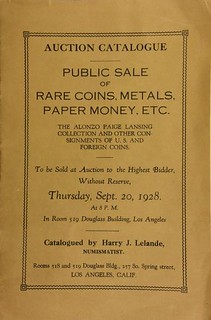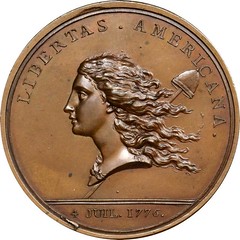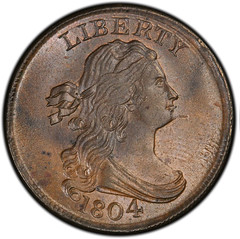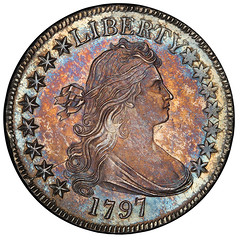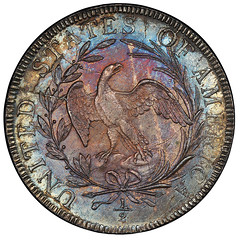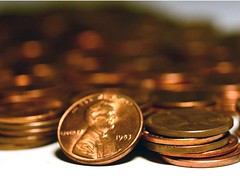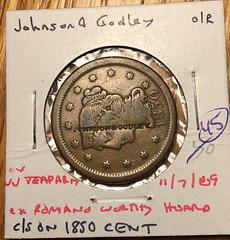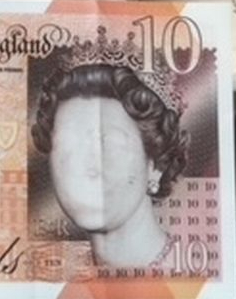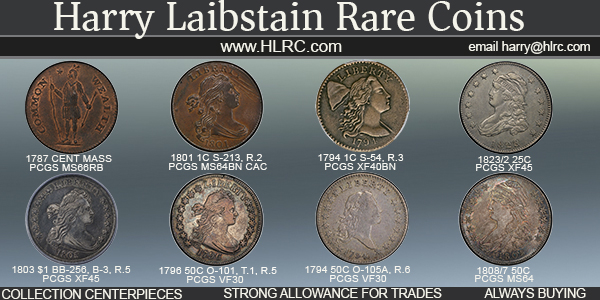
PREV ARTICLE
NEXT ARTICLE
FULL ISSUE
PREV FULL ISSUE
NOTES FROM E-SYLUM READERS: APRIL 4, 2021The Harry Lelande Auction CatalogDave Hirt writes:
Thanks. I added an image of the cover of the American Numismatic Society's copy of Lelande's 1928 sale from the Newman Numismatic Portal. It's a nice sale of varied material including colonials, a Chain cent, medals, a Lesher dollar, Confederate and Southern States Currency, Encased Postage, and numismatic literature, including an impressive run of The Numismatist. -Editor
To read the catalog on NNP, see:
To read the earlier E-Sylum article, see:
Nathan Markowitz writes:
"Please send to me at : cascades1787@yahoo.com and include as follows:
I will keep the current owner's name and any previous owners' names confidential as you indicate. Many thanks." Great project! Please help if you can. -Editor Bill Eckberg writes: "What Constitutes a Die Variety?
"Personally, I think any alteration has to be significant and not accidental. In the half cent world, the 1795 no-pole obverse is just a reground with-pole obverse that was used earlier. Similarly, the Spiked Chin obverse was apparently the result of some kind of damage. I consider both of those to be die states after their alteration, whether intentional or accidental." Bill's short question could prompt some lengthy answers. Dick Johnson's Encyclopedia doesn't have a lot to say about varieties. I would just note that the discovery, naming and categorization of die varieties is driven by collectors of coins struck by the dies. Collectors notice and care about differences among the coins they collect. Many differences stem from the dies, and the reasons for the differences are many - dies wear over time, and they can be lightly or heavily retouched by engravers, they can break and either continue to be used or be replaced with entirely new dies. Dies are closely held by the mints and few end up in museum or collector hands where they can be examined. Typically the only evidence of a die's existence or state comes indirectly from the coins struck from the die, which in turn can experience further wear and deterioration of their own before coming to rest in a collection. Some varieties are boldly visible. Others are much more subtle. So where does one draw the line? Individual collectors can make their own decisions about what to collect. But what is the broad consensus about what constitutes a die variety? Where have the good/better/best definitions been published? Saul Teichman writes: "It is questionable to me whether or not the recently sold 1797 Lelan Rogers-Pogue half dollar is ex Brand. "Brand owned the following 9 examples of which only one was described as Unc, the example that appeared in the April 1906 St Louis Stamp & Coin sale of the George W. Rice collection as highlighted below." Saul has been studying the digitized Virgil Brand ledgers at the American Numismatic Society library via the Newman Numismatic Portal. -Editor Saul adds: "The Rice coin is imaged in the plated copy of that sale on the Newman portal with the description at the following link - https://archive.org/details/largevaluablecol00stlo/page/10/mode/2up and the coins image plated at this link - https://archive.org/details/largevaluablecol00stlo/page/114/mode/2up . "To me the plate matches the Oliver Jung (ANR 7/04 PCGS63 sale) coin more than the Rogers-Pogue coin. "I am curious to know what other people think."
To read the earlier E-Sylum article, see:
Martin Purdy responded to this segment of the article from Franky Leeuwerck. -Editor "The name of printer was too small, less than 2cm, about two grains of rice long. The characters, less than 1.5 mm wide, were too small for my camera to be recognized. If I could only provide a larger image. Now, that thought turned out to be a step in the right direction.
"The Google Translate software tried to recognize the words that were captured by the camera. It was necessary to find the right distance between the camera and the computer screen by holding the phone closer to and further from the screen. Then the answer appeared on the phone : Dai Nippon Printing Co., Ltd. Got it !" Martin writes: "That's pretty impressive, given that those aren't standard "print" characters - I was expecting total disaster as I read this item, as it would be like expecting an OCR program to cope with German Fraktur or Old English type. "
To read the earlier E-Sylum article, see:
Chris Neuzil writes:
Considering that no one seems to be able to read an analog clock dial anymore, I'm not surprised. The same generational effect was likely present after the widespread adoption of mechanical clocks. "Kids these days, can't even read a simple sundial..." I've also flummoxed many a young clerk while trying to simplify change-making. Blank stares. Long pauses. "OK, nevermind - take the debit card." -Editor Jeff Rock writes:
Tony Terranova and I also noticed the Tannenbaum-style holder. -Editor
To read the earlier E-Sylum article, see:
Jeff Rock writes:
"The Columbia farthing article is interesting. It's a series I collected fairly actively for a while, and then ignored for years when the last few varieties I needed never showed up. There is/was a group dedicated to collecting these. Not sure if it is still in existence, and I just looked and while the web pages are all up, none of the photographs were loading. Still, it has some useful information and your readers may be interested in looking at it:
I should also note that the Withers Token Book 2 covers the Columbia farthing series in depth. George Fuld wrote the first detailed description of the various varieties, and his numbers are still used by most US collectors. Years ago I made up a photographic plate of these showing all the known varieties and their die interlocks." Thanks! Too bad about the images on the club site. Is anyone aware of a new home for them? -Editor
To read the earlier E-Sylum articles, see:
Dave Hirt writes: "The first part of the Jules Fonrobert sale was held in Berlin, Germany Feb 18, 1878. This was the coins, tokens, and medals of North America. The cataloger Adolph Weyl cataloged Federal issues first, then Private issues by State, then City and Town. "The catalog is written in German, which I do not read, but with the US issues, I can figure them out by the description of the item. There is one however that has me completely stumped. It is a silver coin listed under New York city, lot #2920. It realized 46 German Marks, which I believe was rather high price for that era. Weyl gives it a half page description. He lists the date as 1667. A part of the description reads (auf den Sieg der Niederlander aber die britische Flotte bei Chatham and den Frieden von Breda, in welchen das, von den, Niederlandern seit 1614 besessene , 1664 von den Briten under Oberst Nicolls eroberte New York an England abgetreten wurde.) "I have a copy of the Krause book on 17th century world coins, and looked under Netherlands, without success. "I wonder if one of our readers who reads German, and has a Fonrobert catalog could tell us what the connection of this coin to New York City is." Interesting. Can anyone help? -Editor Kavan Ratnatunga writes:
"I erased an Rs200 note clean myself and wrote up with comments from experts. "The Missing Queen on polymer note was a frequent fake error note that was sold on eBay at that time. Don't see any now. As the Fakes are exposed the remainder were probably put back into circulation."
See:
Thanks! -Editor
To read the earlier E-Sylum article, see:
David Pickup writes: "Britain is set to give up decimalisation and return to pounds shillings and pence. The fifty year long experiment has been a success but it is now time for change in Brits' pockets. "The old denominations will be reintroduced gradually over 1st April which will now be called A Day. If all goes well we may return to Libra solidus and denarius. Instead of coins being marked "new pence" will now be "new old pence" or "old new pence". "Authorities are also thinking of reintroducing those handy denominations that were so popular such as the third and quarter farthing, 1 1/2 pence and Cartwheel twopence. If goes well they will re-introduce the noble and angel. "It is to be hoped that other countries will return to pre decimal currency. The USA may adopt the same system and perhaps our European friends will keep the euro but have twelve schillings and 240 pfennigs/centimes. " Yeah, that's going to happen... -Editor
Wayne Homren, Editor The Numismatic Bibliomania Society is a non-profit organization promoting numismatic literature. See our web site at coinbooks.org. To submit items for publication in The E-Sylum, write to the Editor at this address: whomren@gmail.com To subscribe go to: https://my.binhost.com/lists/listinfo/esylum All Rights Reserved. NBS Home Page Contact the NBS webmaster 
|
